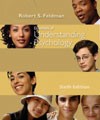Robert S. Feldman,
University of Massachusetts, Amherst
| anorexia nervosa | A severe eating disorder in which people may refuse to eat, while denying that their behavior and appearance,which can become skeletonlike, are unusual anorexia_nervosa (219.0K) anorexia_nervosa (219.0K)
|
 |
 |
 |
| arousal approaches to motivation | The belief that we try to maintain a certain level of stimulation and activity, increasing or reducing them as necessary
|
 |
 |
 |
| bulimia | A disorder in which a person binges on incredibly large quantities of food, then purges by vomiting or by using laxatives bulimia (183.0K) bulimia (183.0K)
|
 |
 |
 |
| Cannon-Bard theory of emotion | The belief that both physiological and emotional arousal are produced simultaneously by the same nerve stimulus
|
 |
 |
 |
| cognitive approaches of motivation | The theory suggesting that motivation is a product of people's thoughts and expectations-their cognitions
|
 |
 |
 |
| display rules | The guidelines that govern the appropriateness of showing emotion nonverbally
|
 |
 |
 |
| drive | Motivational tension, or arousal, that energizes behavior in order to fulfill some need
|
 |
 |
 |
| drive-reduction approaches to motivation | A theory suggesting that when people lack some basic biological requirement such as water, a drive to obtain that requirement (in this case, the thirst drive) is produced
|
 |
 |
 |
| emotions | Feelings that generally have both physiological and cognitive elements and that influence behavior
|
 |
 |
 |
| facial-affect program | The activation of a set of nerve impulses that make the face display the appropriate expression
|
 |
 |
 |
| facial-feedback hypothesis | The hypothesis that facial expressions not only reflect emotional experience, they also help determine how people experience and label emotions
|
 |
 |
 |
| homeostasis | The body's tendency to maintain a steady internal state
|
 |
 |
 |
| incentive approaches to motivation | The theory suggesting that motivation stems from the desire to obtain valued*external goals, or incentives.
|
 |
 |
 |
| instincts | Inborn patterns of behavior that are biologically determined rather than learned
|
 |
 |
 |
| James-Lange theory of emotion | The belief that emotional experience is a reaction to bodily events occurring as a result of an external situation ("I feel sad because I am crying")
|
 |
 |
 |
| metabolism | The rate at which food is converted to energy and expended by the body
|
 |
 |
 |
| motivation | The factors that direct and energize the behavior of humans and other organisms
|
 |
 |
 |
| need for achievement | A stable, learned characteristic in which satisfaction is obtained by striving for and attaining a level of excellence
|
 |
 |
 |
| need for affiliation | An interest in establishing and maintaining relationships with other people
|
 |
 |
 |
| need for power | A tendency to seek impact, control, or influence over others, and to be seen as a powerful individual
|
 |
 |
 |
| obesity | The state of being more than 20 percent above the average weight for a person of one's height obesity (121.0K) obesity (121.0K)
|
 |
 |
 |
| Schachter-Singer theory of emotion | The belief that emotions are determined jointly by a nonspecific kind of physiological arousal and its interpretation, based on environmental cues. Schachter-Singer (239.0K) Schachter-Singer (239.0K)
|
 |
 |
 |
| self-actualization | According to Rogers, a state of self-fulfillment in which people realize their highest potential
|
 |
 |
 |
| weight set point | The particular level of weight that the body strives to maintain
|



 2002 McGraw-Hill Higher Education
2002 McGraw-Hill Higher Education

 2002 McGraw-Hill Higher Education
2002 McGraw-Hill Higher Education